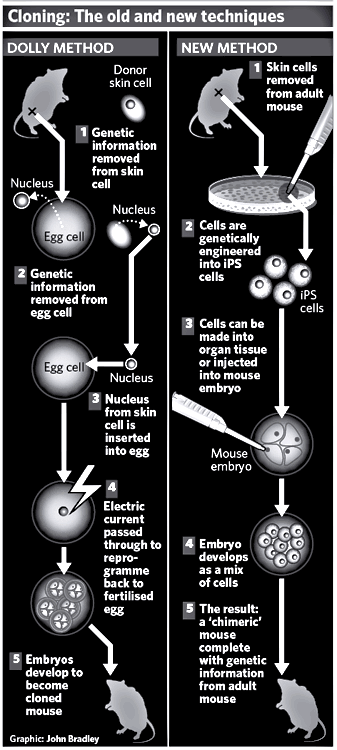'Now we have the technology that can make a cloned child'

A new form of cloning has been developed that is easier to carry out than the technique used to create Dolly the sheep, raising fears that it may one day be used on human embryos to produce "designer" babies.
Scientists who used the procedure to create baby mice from the skin cells of adult animals have found it to be far more efficient than the Dolly technique, with fewer side effects, which makes it more acceptable for human use.
The mice were made by inserting skin cells of an adult animal into early embryos produced by in-vitro fertilisation (IVF). Some of the resulting offspring were partial clones but some were full clones – just like Dolly.
Unlike the Dolly technique, however, the procedure is so simple and efficient that it has raised fears that it will be seized on by IVF doctors to help infertile couples who are eager to have their own biological children.
One scientist said this weekend that a maverick attempt to perform the technique on humans is now too real to ignore. "It's unethical and unsafe, but someone may be doing it today," said Robert Lanza, chief scientific officer of American biotechnology company Advanced Cell Technology.
"Cloning isn't here now, but with this new technique we have the technology that can actually produce a child. If this was applied to humans it would be enormously important and troublesome," said Dr Lanza, whose company has pioneered developments in stem cells and cell reprogramming.
"It raises the same issues as reproductive cloning and although the technology for reproductive cloning in humans doesn't exist, with this breakthrough we now have a working technology whereby anyone, young or old, fertile or infertile, straight or gay can pass on their genes to a child by using just a few skin cells," he said.
The technique involves the genetic reprogramming of skin cells so they revert to an embryonic-like state. Last year, when the breakthrough was used on human skin cells for the first time, it was lauded by the Catholic Church and President George Bush as a morally acceptable way of producing embryonic stem cells without having to create or destroy human embryos.
However, the same technique has already been used in another way to reproduce offspring of laboratory mice that are either full clones or genetic "chimeras" of the adult mouse whose skin cells were reprogrammed.
The experiments on mice demonstrated that it is now possible in principle to take a human skin cell, reprogramme it back to its embryonic state and then insert it into an early human embryo. The resulting child would share some of the genes of the person who supplied the skin tissue, as well as the genes of the embryo's two parents.
These offspring are chimeras – a genetic mix of two or more individuals – because some of their cells derive from the embryo and some from the skin cell. Technically, such a child would have three biological parents. Human chimeras occur naturally when two embryos fuse in the womb and such people are often normal and healthy. Dr Lanza says there is no reason to believe that a human chimera created by the new technique would be unhealthy.
Furthermore, studies on mice have shown that it is possible to produce fully cloned offspring that are 100 per cent genetically identical to the adult. This was achieved by using a type of defective mouse embryo with four sets of chromosomes instead of the normal two.
This "tetraploid" embryo only developed into the placenta of the foetus and when it was injected with a reprogrammed skin cell, the rest of the foetus developed from this single cell to become a full clone of the adult animal whose skin was used.
None of the scientists working on cell reprogramming to produce induced pluripotent stem (iPS) cells – as the embryonic cells are known – plan to use it for human reproductive medicine. Their main aim is to produce stem cells for the therapeutic treatment of conditions such as Parkinson's, Alzheimer's and stroke.
However, Dr Lanza said that the mouse experiments his company had done demonstrated how easily the technology could be used to produce cloned or chimeric babies by inserting iPS cells into early human embryos. This is not banned in many countries, where legislation has not kept pace with scientific developments.
In Britain, the Human Tissue and Embryos Bill going through Parliament does not mention the iPS technique, although experts believe that the new law should make it illegal because it involves genetic modification of cells that become part of the embryo.
"In addition to the great therapeutic promise demonstrated by this technology, the same technology opens a whole new can of worms," Dr Lanza said.
"At this point there are no laws or regulations for this kind of thing and the bizarre thing is that the Catholic Church and other traditional stem-cell opponents think this technology is great when in reality it could in the end become one of their biggest nightmares," he said. "It is quite possible that the real legacy of this whole new programming technology is that it will be introducing the era of designer babies.
"So for instance if we had a few skin cells from Albert Einstein, or anyone else in the world, you could have a child that is say 10 per cent or 70 per cent Albert Einstein by just injecting a few of their cells into an embryo," he said.
Join our commenting forum
Join thought-provoking conversations, follow other Independent readers and see their replies
Comments